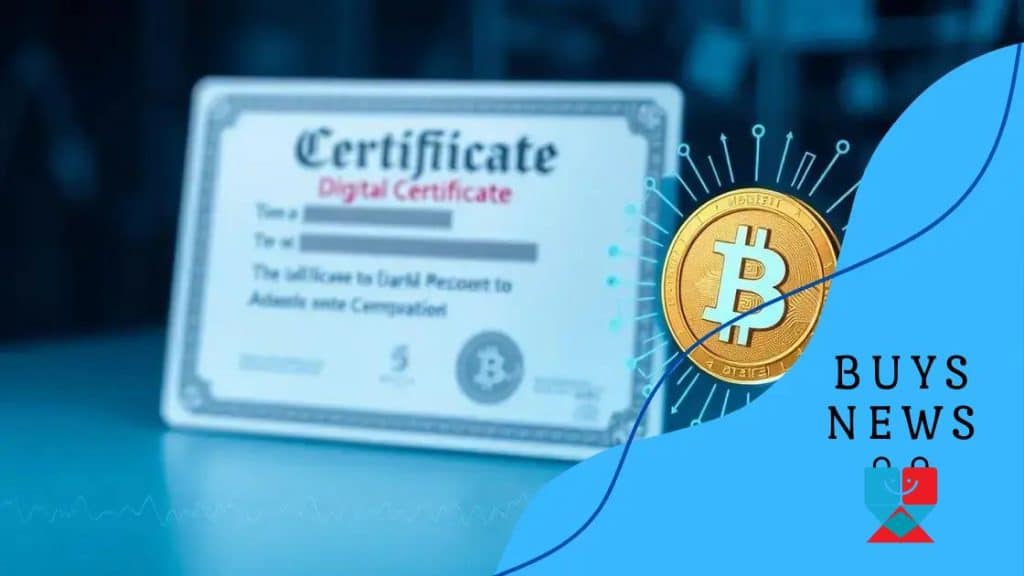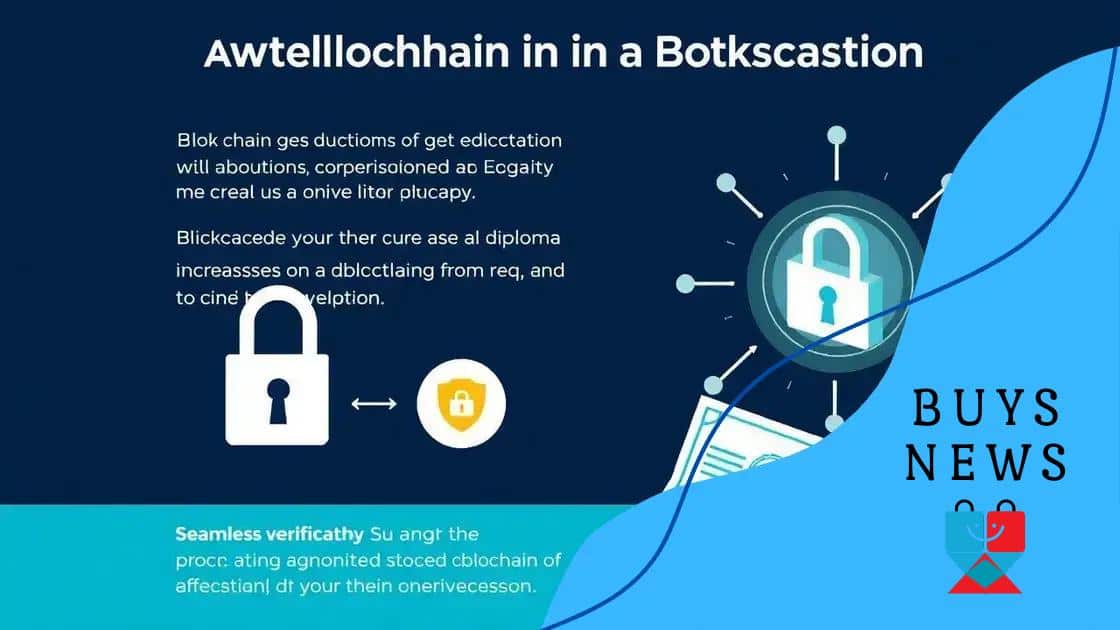Blockchain for academic credential security: ensuring trust

Blockchain for academic credential security provides a secure, tamper-proof system that enhances the integrity and verification of diplomas and certifications, streamlining the hiring process for employers.
Blockchain for academic credential security is changing how we think about verifying qualifications. Imagine having a tamper-proof record of your achievements accessible anywhere, anytime. This could redefine trust in education.
Understanding blockchain technology
Understanding blockchain technology is essential for anyone looking to explore its applications in various fields, especially in education. At its core, blockchain is a decentralized and secure digital ledger that records transactions across multiple computers, ensuring that data cannot be altered retroactively.
Key Features of Blockchain
Blockchain offers several key features that make it particularly useful. These include:
- Decentralization: Unlike traditional systems that rely on a central authority, blockchain operates on a network of computers.
- Transparency: Transactions are visible to all participants in the network, promoting trust.
- Immutability: Once recorded, data cannot be changed or deleted, ensuring authenticity.
These features make blockchain a powerful tool for securing academic credentials. By using blockchain, educational institutions can issue verified diplomas and certificates that are easily accessible and verifiable by employers and other institutions. Imagine applying for a job and being able to provide an immediate and tamper-proof record of your academic achievements.
How Blockchain Works
To grasp blockchain technology better, it’s important to understand how it operates. Each transaction is grouped into a block, which is then added to a chain of previous blocks, hence the name ‘blockchain.’ This chain is stored across the network, ensuring that every participant has a copy. When a new block is made, it must be confirmed by other network members, which is done through a process called consensus.
Furthermore, each block contains a list of transactions, a timestamp, and a unique code called a hash. This hash connects it to the previous block, forming a secure chain. If someone attempts to alter a single block, the hash changes, and it no longer matches with the other blocks, alerting the network to the tampering.
In essence, blockchain technology can transform how we handle educational records. It not only enhances security but also streamlines the verification process, saving time and resources for both institutions and graduates.
How blockchain protects academic credentials
How blockchain protects academic credentials is a vital topic in today’s digital age. By using blockchain technology, educational institutions can create secure, verifiable records of students’ achievements. This is especially important as diploma fraud becomes more common.
Mechanisms of Protection
The security of academic credentials on the blockchain is achieved through various mechanisms. Each credential is stored as a digital record on the blockchain, making it nearly impossible to alter once created. The key elements of this protection include:
- Encryption: Data is securely encrypted, making it unreadable to unauthorized users.
- Decentralization: No single authority controls the data, reducing the risk of manipulation.
- Consensus Protocols: Transactions must be verified by multiple parties before being added to the blockchain, ensuring accuracy.
This means that when a student graduates, their diploma is recorded as a unique entry. Employers can easily verify this entry using a public blockchain. This not only saves time but also builds trust between potential employers and graduates.
Real-World Applications
Many universities are beginning to adopt blockchain technology for this very reason. They are issuing digital diplomas that are recorded on a blockchain. This allows students to share their academic credentials with employers quickly and easily. Moreover, by leveraging smart contracts, institutions can automate the verification process, which enhances efficiency.
Furthermore, universities can maintain a permanent and tamper-proof record of all achievements, including degrees and certifications. This reduces instances of fraud and adds significant value to the educational system. Students can have confidence in their qualifications being recognized globally, without the fear of misrepresentation or questioning their validity.
It is evident that using blockchain technology provides a robust solution for protecting academic credentials, paving the way for a more secure and trustworthy education landscape.
Advantages of blockchain in education

The advantages of blockchain in education are significant and wide-ranging. This technology can reshape how we manage academic records and enhance the educational experience. By offering a transparent and secure method for recording credentials, blockchain addresses many of the challenges currently faced in the education sector.
Enhanced Security
One of the primary benefits is increased security. Academic records stored on the blockchain are tamper-proof. Once a record is created, it cannot be altered or deleted, which greatly reduces the risk of fraud. Educational institutions can confidently issue verified diplomas, knowing they are protected.
Simplified Verification Process
Another advantage is the simplified verification process for employers. With blockchain, potential employers can easily access and verify candidates’ academic credentials. This speeds up the hiring process and reduces the burden on both job seekers and hiring managers. Instead of contacting schools for verification, employers can refer to immutable records on the blockchain.
- Time-efficient: Verification is faster, leading to quicker hiring decisions.
- Cost-saving: Institutions save money on administrative tasks for record verification.
- Trust-building: Employers can trust the information provided, knowing it’s secure.
This system not only improves efficiency but also builds trust in the educational qualifications presented by candidates. It encourages a culture of honesty where achievements can be easily verified.
Accessibility and Portability
Blockchain also enhances accessibility to educational records. Students can have their diplomas and transcripts stored on a digital wallet. This means they can share their achievements without the need for physical copies. Graduates have portability; their credentials can be shared anytime and anywhere with a click of a button. This ease of sharing can be particularly beneficial for students looking to study abroad or apply for jobs in different regions.
Furthermore, this accessibility promotes lifelong learning. Students can accumulate certificates and skills over time, which are securely stored on the blockchain. They can showcase their growing knowledge and career development efficiently, helping them stand out in a competitive job market. Overall, the advantages of blockchain in education pave the way for a more secure, efficient, and trustworthy system of managing academic credentials.
Real-world applications of blockchain in credentialing
Real-world applications of blockchain in credentialing are emerging rapidly as educational institutions and organizations recognize its benefits. This technology enables the creation of secure and verifiable academic records that can be easily accessed by anyone, anywhere.
Digital Diplomas
One of the most prominent examples is the issuance of digital diplomas. Universities and colleges are using blockchain to issue diplomas and certificates directly to graduates. These digital credentials are stored securely and can be shared with potential employers instantly. This method eliminates the need for traditional physical diplomas, which can be lost or damaged over time.
Verification Services
Alongside digital diplomas, many companies have begun offering verification services powered by blockchain. These platforms allow employers to verify a candidate’s educational credentials quickly and efficiently. Instead of calling schools or waiting for paperwork, employers can access a blockchain record that provides real-time verification. This process saves time and enhances trust in the hiring process.
- Efficiency: Verification occurs in seconds rather than days.
- Accuracy: Employers receive accurate, tamper-proof information.
- Reduced Fraud: Blockchain minimizes the chances of credential fraud.
This growing trend is based on the unique features of blockchain technology that ensure security and integrity. As educational institutions adopt these applications, candidates can showcase their skills and qualifications with confidence.
Skills Badges
Another exciting application is the use of digital badges that represent specific skills or achievements. Organizations can award badges to individuals who complete training programs or online courses. These badges are then stored on the blockchain, allowing individuals to share their accomplishments with employers and others easily. This can be especially beneficial in fast-paced industries where skills can change rapidly.
Furthermore, blockchain provides a transparent way to track and display the learning journey of each individual. By being able to display both credentials and skills, candidates can stand out in competitive job markets, demonstrating both education and practical abilities. The real-world applications of blockchain in credentialing are paving the way for a more secure, efficient, and accountable educational landscape.
Future trends in academic credential security
The future trends in academic credential security are shaping how educational institutions and employers manage qualifications. As technology continues to evolve, blockchain is expected to play an even more significant role in ensuring the safety and integrity of academic records.
Increased Adoption of Blockchain Technology
Institutions worldwide are beginning to recognize the potential of blockchain. Many are already experimenting with issuing diplomas and certificates on blockchain networks. This trend is likely to grow as more schools see the value in providing secure, verifiable records that are accessible for both students and employers.
Integration with Other Technologies
Future developments may include integrating blockchain with other technologies, such as artificial intelligence and machine learning. These integrations can enhance the efficiency of credential verification processes. For example, AI could analyze credentials to provide insights on candidate qualifications effectively.
- Enhanced Security: Coupling AI with blockchain will create a more robust security framework.
- Automated Verification: AI can help automate the verification process, making it quicker and less prone to error.
- Data Analysis: Machine learning algorithms can analyze trends in educational credentials to improve processes.
As technology advances, institutions will likely look to these integrations as a way to streamline administrative tasks and improve operational efficiency.
Global Standardization
Another important trend will be the push towards global standardization of credentials. Educational institutions around the world may begin to collaborate, creating a universal format for diplomas and certificates stored on the blockchain. This would enhance the recognition of qualifications internationally and simplify the process for students moving across borders.
Global standardization could also lead to a more trustworthy system where employers have a reliable method of verifying qualifications, regardless of where an applicant studied. As we look to the future, the changes in academic credential security will pave the way for an educational landscape that is more secure, efficient, and interconnected.
In conclusion, the future of academic credential security looks promising, thanks to the rise of blockchain technology. As institutions increasingly adopt digital diplomas and verification services, students and employers will benefit from a more secure and efficient process. The integration of artificial intelligence will streamline these systems even further. Additionally, global standardization will facilitate easier recognition of qualifications across borders. Overall, these trends will create a more trustworthy educational landscape, ensuring that academic achievements are securely recorded and verified.
FAQ – Questions about blockchain for academic credential security
What is blockchain technology?
Blockchain is a decentralized digital ledger that records transactions across many computers, ensuring that data cannot be altered retroactively.
How does blockchain enhance academic credential security?
Blockchain provides a tamper-proof system for storing academic records, ensuring that diplomas and certificates cannot be altered once issued.
What are the benefits of digital diplomas?
Digital diplomas are easily verifiable by employers, saving time and reducing the risk of fraudulent credentials.
Will blockchain lead to global standardization of academic credentials?
Yes, as institutions adopt blockchain, there is a potential for creating a universal format for diplomas, simplifying recognition across borders.





